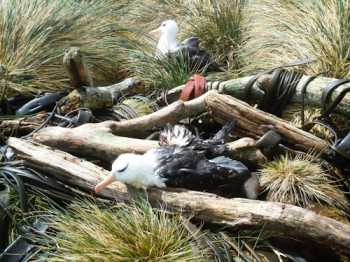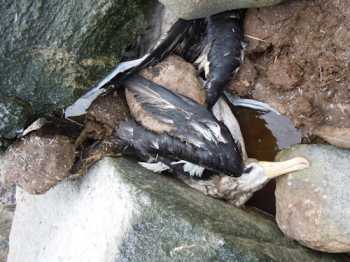Beauchêne Island in the South Atlantic Ocean harbours the second largest breeding colony of the Endangered Black-browed Albatross Thalassarche melanophris in the World, the largest colony being found at Steeple Jason Island, also in the South Atlantic. More than 100 000 pairs of Black-browed Albatrosses breed in dense colonies, mostly along the western coast and in the south of Beauchêne, which is approximately 170 ha in size. Large numbers of Southern Rockhopper Penguins Eudyptes chrysocome also nest within these mixed colonies.
Due mostly to its remote nature, Beauchêne Island is rarely visited. In December 2010 a small research team spent three weeks camping on the island to conduct a range of studies on the island's Rockhopper Penguins and Black-browed Albatrosses. During this period the area was affected by a particularly severe storm event, which had significant consequences for the island's seabird populations. A deep low-pressure system had been building up from the Drake Passage, and by the time it hit Beauchêne Island (on the afternoon of 13 December) the wind speed had increased to 60-80 knots, resulting in open ocean swells in excess of 10 metres. The wind and swell were from a south-westerly direction, making the south and west coasts of the island, where the majority of the seabirds nests, especially exposed.
As the wind increased in strength, the albatrosses hunkered down on their nests and many were observed using their wings to anchor themselves. By the evening of 13 December waves breaking on the western coast had reached some of the nesting seabirds on the southern and western side of the island. A single wave was observed breaking over an area comprising about 100 Black-browed albatross nests, a similar number of Rockhopper Penguin nests, and about 30 Imperial Cormorant Phalacrocorax atriceps nests, pulling out to sea many of the adult birds in the process. The storm continued to intensify through the night, and surveys conducted the following day revealed that the strong winds and large waves had resulted in a substantial loss of eggs and chicks, especially for Black-browed Albatrosses, Rockhopper Penguins and Gentoo Penguins Pygoscelis papua.







Most Rockhopper Penguin nests had small chicks at the time, and the albatross nests had a mixture of eggs and recently hatched chicks. The area most severely affected by the storm, which contained approximately 12 000 to 13 000 Black-browed Albatross nests, suffered almost 100% breeding failure. Although many adult albatrosses were still sitting on or near their nests, these were all flooded. Large numbers of eggs and dead chicks lay strewn across the colony, and there was evidence of waves having reached areas relatively high up in the colony. Many adult albatrosses were found pinned under rocks or tree trunks that had washed up during previous storms, others were entangled in kelp, and an estimated 300 adult birds died as a result, the majority of which were Black-browed Albatrosses. Some adult birds, weak and injured as a consequence of the storm, were observed attempting to leave the colony, but were unable to gain sufficient height to fly over the breaking waves. These birds were battered by the large waves, and later washed up on the shore either dead or with broken wings. Other areas on the island which were more elevated, and so were not impacted directly by the breaking waves, were also found to have suffered significant breeding failure, probably due to exposure to the strong wind and the deluge of heavy salt spray over the island.
Although there are previous reports of rough seas around Beauchêne Island, none has recorded relatively large numbers of adult birds dying as a consequence. The storm of 13-14 December 2010 had a severe impact on the breeding success of seabirds at a number of other islands in the South Atlantic. At Steeple Jason Island, the storm also resulted in the death of adult birds, although in fewer numbers than were observed on Beauchêne Island.
Click here to access the ACAP Species Assessment for the Black-browed Albatross.
With thanks to Anton Wolfaardt for photographs and information.
John Cooper, ACAP Information Officer, 9 February 2011

 English
English  Français
Français  Español
Español